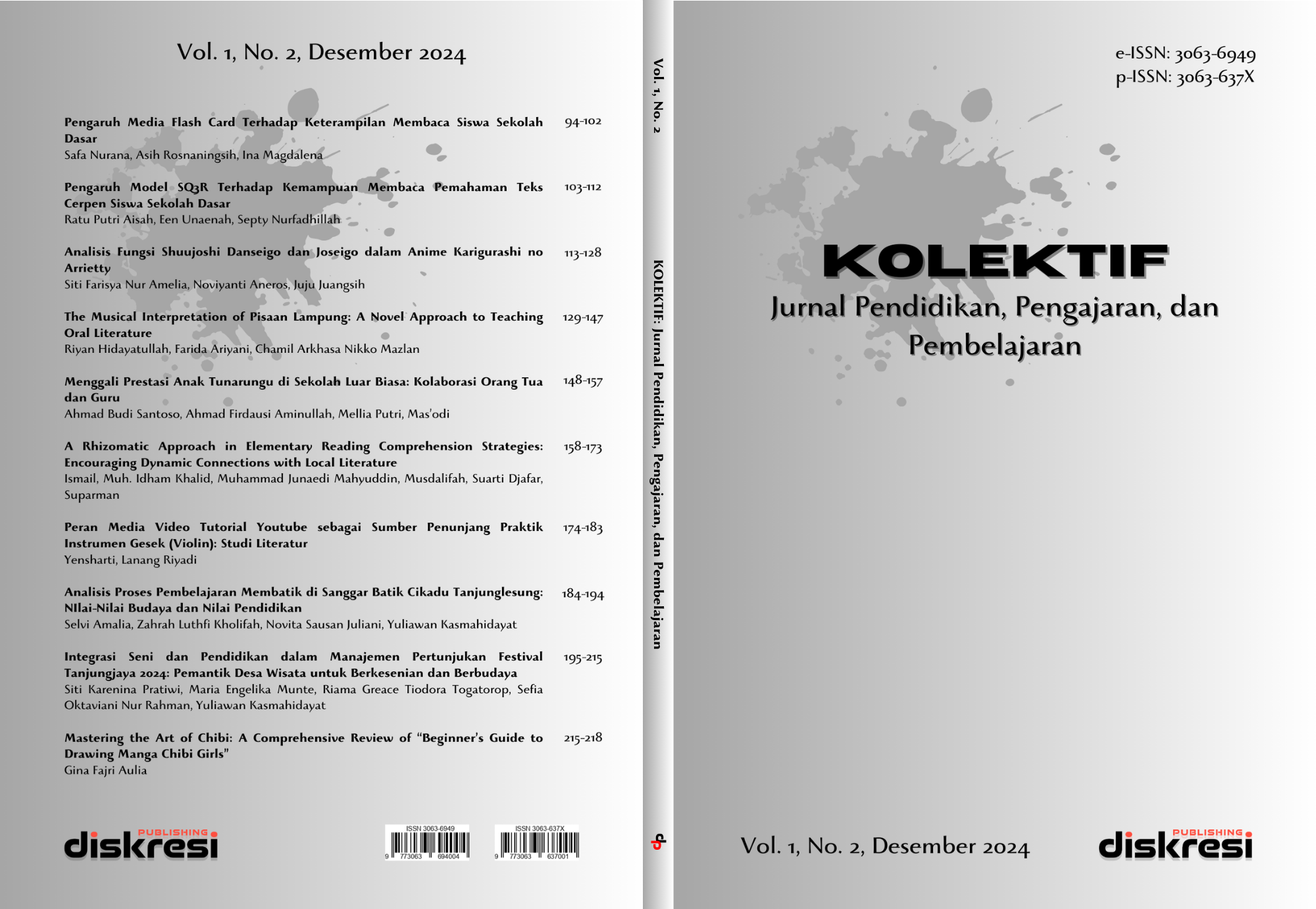A Rhizomatic Approach in Elementary Reading Comprehension Strategies
Encouraging Dynamic Connections with Local Literature
DOI:
https://doi.org/10.70078/kolektif.v1i2.41Keywords:
Rhizomatic Learning, Local Literature, Reading Comprehension, Critical Thinking, Literacy EducationAbstract
This study explores the effectiveness of a rhizomatic approach in enhancing reading comprehension through the integration of local literature at SD Negeri 161 Enrekang, South Sulawesi, Indonesia. Literacy skills, particularly reading comprehension, are critical for academic success, yet traditional teaching methods often fail to engage students or foster critical thinking. While rhizomatic learning has proven effective in higher education, its application in primary education remains underexplored. This study employed a mixed-methods design, incorporating classroom observations, analysis of students' written responses, and pre-test and post-tests to measure the impact of this approach on student engagement and comprehension. The findings revealed significant improvements in reading comprehension, with students demonstrating greater engagement and the ability to make personal and cultural connections with the texts. These results suggest that the rhizomatic approach, integrated with local literature, can create a more interactive and meaningful learning experience for young learners. The study emphasizes the importance of culturally relevant texts in enhancing literacy skills and provides insights into the potential of non-linear learning frameworks in primary education. Further research is recommended to examine the long-term effects and scalability of this approach.
Downloads
References
Cormier, D. (2008). Rhizomatic Education: Community as Curriculum. Innovate, 4(5). http://www.innovateonline.info/index.php?view=article&id=550
Correia, A., Água, P., & Conceição, V. (2024). AI in Education: a Comparative Study of Rhizomatic and Connectivism Pedagogical Theories. INTED2024 Proceedings, 1, 4548–4555. https://doi.org/10.21125/inted.2024.1179
Deleuze, G., & Guattari, F. (2007). Introduction: Rhizome: From the book Transatlantic Literary Studies. In A thousand plateaus: Capitalism and schizophrenia. Edinburgh University Press. https://doi.org/10.1515/9781474470674-039/pdf
Delgado, P. (2021). Culturally relevant literature for k-5 students. Texas Journal of Literacy Education, 9(1), 35–44. https://www.talejournal.com/index.php/TJLE/article/view/75
Delgado-Ron, J. A., & Andrade-Rivas, F. (2023). Unwanted or Mistimed Pregnancy and Developmental Issues in Ecuadorian Children Aged 3 to 5: A Doubly Robust Estimate Using Data from the National Health and Nutrition Survey 2018. Maternal and Child Health Journal, 27(9), 1672–1682. https://doi.org/10.1007/s10995-023-03713-5
Dillon, M. (2016). Learning happens: Incorporating a rhizomatic perspective into teaching and learning. Adult Education Research Conference, 90–95. https://newprairiepress.org/aerc/2016/papers/15
Duncum, P. (2015). Transforming Art Education into Visual Culture Education Through Rhizomatic Structures. Anadolu Journal of Educational Sciences International, November, 47–64.
Ebe Ann E. (2010). Culturally Relevant Texts and Reading Assessment for English Language Learners. Reading Horizons: A Journal of Literacy and Language Arts, 50(3), 193–210. https://scholarworks.wmich.edu/reading_horizons/vol50/iss3/5
Gay, G. (2018). Culturally Responsive Teaching: Theory, Research, and Practice (Third Edit). Teachers College Press.
Ismail. (2015). Pangan Lokal. Unimen Press.
Ismail. (2024a). Jejak Langkah Menuju Keindahan Kebun Anggrek. KBM Indonesia. www.penerbitbukumurah.com
Ismail. (2024b). Pesona Warisan Budaya. Unimen Press.
Ismail. (2024c). Petualangan di Awan: Literasi Cloud Untuk Anak. KBM Indonesia. www.penerbitbukumurah.com
Ismail. (2024d). Rantai Makanan. Unimen Press.
Ismail. (2024e). Taman Pangan Stunting: Membangun Kesehatan dengan Makanan Sehat. KBM Indonesia. www.penerbitbukumurah.com
Ismail, & Tini. (2024a). Air Mata Katak Todan. Unimen Press.
Ismail, & Tini. (2024b). Sekolahku Sehat. KBM Indonesia. www.penerbitbukumurah.com
Jafar Jahani, Emarat, A. D., Marzooqi, R., & Sarvestani, M. S. (2023). Rhizomatic-based educational model and its effect on creative thinking. The Journal of New Thoughts on Education, 19(2), 7–33. https://doi.org/10.22051/jontoe.2021.25369.2593
Jahangiri, E., Mahdizadeh, A., Esmaeilzadeh, Z., & Araghieh, A. (2024). Identification of Components and Indicators of Rhizomatic Knowledge-Based Curriculum in Elementary School. Sociology of Education, 10(2), 66–77.
Kicha, L. (2023). A Systematic Review: Local Literature in Integrated Skills for English Teaching. Journal of English Language Teaching, Literature and Culture, 2(1), 59–66. https://doi.org/10.53682/jeltec.v2i1.6494
Leu, D. J., McVerry, J. G., O’Byrne, W. I., Kiili, C., Everett-Cacopardo, L. Z. H., Kennedy, C., & Forzani, E. (2011). The New Literacies of Online Reading Comprehension: Expanding the Literacy and Learning Curriculum. Journal of Adolescent & Adult Literacy, 55(1), 5–14. https://doi.org/10.1598/JA
Lu, L., & Chang, H. M. (2022). Rhizomatic Encounters With Inter/Transmedia Art: A Pedagogy for Learning and Teaching Experiential Contemporary Art. Studies in Art Education, 63(1), 9–24. https://doi.org/10.1080/00393541.2021.2007726
Malawi, I., Tryanasari, D., & Kartikasari, A. (2017). Using Local Literature as Learning Literacy. Proceeding International Seminar of Primary Education, 1, 47–52.
Mandinach, E. B., & Abrams, L. M. (2022). Data Literacy and Learning Analytics. The Handbook of Learning Analytics, 196–204. https://doi.org/10.18608/hla22.019
Pattison, H. D. A. (2014). Rethinking Learning to Read: The Challenge from Children Educated at Home [PhD Thesis]. University of Birmingham.
Peggy Laughlin. (2008). Destination Literacy: A Service Learning, Culturally Responsive Literacy Project. The American Educational Research Association Annual Meeting.
Rimban, E. L. (2024). Rhizomatic Pedagogy in the Age of Artificial Intelligence. Available at SSRN 4734793.
Sajjadi, S. M. (2014). Can Religious Education be Rhizomatic? Middle-East Journal of Scientific Research, 19(1), 42–47. https://doi.org/10.5829/idosi.mejsr.2014.19.1.11424
Smitka, J. A. M. (2012). Rhizomatic explorations in curriculum. Alberta Journal of Educational Research, 58(2), 185–197. https://doi.org/10.55016/ojs/ajer.v58i2.55586
Snow, C. (2017). Reading for understanding : toward a research and development program in reading comprehension. Rand Corporation. https://doi.org/10.1044/leader.ov.22102017.np
Downloads
Published
How to Cite
Issue
Section
License
Copyright (c) 2024 Ismail Ismail, Muh. Idham Khalid, Muhammad Junaedi Mahyuddin, Musdalifah Musdalifah, Suarti Djafar, Suparman Suparman

This work is licensed under a Creative Commons Attribution-ShareAlike 4.0 International License.






